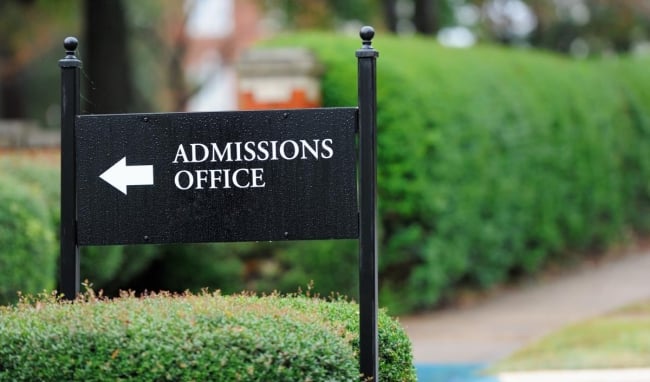You have /5 articles left.
Sign up for a free account or log in.

iStock.com/sshepard
Some experts suggest that top colleges would admit more minority and low-income students if they stressed nontraditional factors in admissions, such as essays, interviews or extracurricular activities. The theory is that minority and low-income students have more chances with these criteria to show their worthiness to be accepted. Scores on standardized tests have been controversial for years, in large part because Black and Latinx students, on average, do not do as well as white and Asian students on the SAT or the ACT.
A new research paper suggests that that there is some -- but only some -- truth to these widely held beliefs. Increasing the emphasis on criteria other than grades in college preparatory courses and test scores on standardized tests "may do little to ameliorate -- and in some cases, may exacerbate -- existing enrollment inequities," the study found. But placing less emphasis on standardized tests worked and resulted in a more diverse pool of students being admitted.
A paper describing the research -- by Kelly Ochs Rosinger, Karly Sarita Ford and Junghee Choi, all of Pennsylvania State University -- was published last week in The Journal of Higher Education.
The scholars used Barron's Profile of American Colleges and studied data from 368 institutions (95 public and 273 private) that were classified as "very," "highly" and "most" competitive in admissions. Data from 2008 to 2016 were studied. They then looked at the Common Data Set survey that asked colleges to rank various criteria for admitting students as “not considered,” “considered,” “important” and “very important.” Most colleges ranked grades in high school courses as very important. But the data set also included many other factors that were considered, including minority status and status as a first-generation college student.
The researchers then grouped together factors that they deemed to be similar. All of the categories related to time outside school (activities, volunteering, work) were grouped together. They also grouped together a "subjective" category (character, talent, applicant interest, interview, essays and recommendations).
Then they evaluated how colleges did at enrolling a diverse class (by race and economics, using Pell Grant recipients as a proxy) by how they rated various categories.
Across all institutional types, grade point average and rigor were the most important considerations for admission. Test scores were the next more important factor, but they played a more important role at public institutions.
Extracurricular involvement (activities, volunteering and work) and subjective factors (character, talent, applicant interest, interviews, essays and recommendations) were the next most important factors, with most institutions ranking them as either “considered” or “important.” "Private and the most selective institutions ranked these factors as more important than other institutions on average," the paper says.
The findings: "Most institutions across all groupings ranked applicants’ background characteristics -- racial minority, first-generation, and legacy status, and geography -- as either 'not considered' or 'considered,' with few ranking them as important. Again, private and the most selective institutions in our sample ranked background characteristics as more important on average than other institutional types."
The paper continues, "Our findings indicate that extracurricular involvement and subjective assessments of interviews, essays, recommendations as well as applicant’s interest in the institution, talent, and character, which all reflect ambiguous evaluation criteria, related to lower levels of Pell recipient enrollment at some institutional types. Extracurriculars and subjective factors, however, did not relate to racially marginalized student enrollment, indicating these considerations may do little to dramatically alter enrollment for these students in either more or less equitable ways."
The only factor that consistently helped with diversity: de-emphasizing test scores.
Why do these techniques (except for less emphasis on testing) fail? "The recruitment practices of public institutions reveal a preference for schools located in wealthy out-of-state neighborhoods. Private college recruiting strategies -- the locations they visit and the ways in which they identify high-achieving students -- also influence the numbers of low-income students who enroll. If recruitment efforts and financial aid offers do not change simultaneously, admissions practices will inevitably be constrained as a lever for creating more equitable opportunities for students to access the benefits conferred upon those who attend selective colleges. Recent admissions scandals in which high-income parents pay coaches and other campus administrators and donate money in exchange for admission have demonstrated that admissions processes can easily be superseded by those with money. Thus, comprehensive approaches and commitments to equity at the recruiting, admissions, financial aid, and enrollment stages are necessary to support racial and economic diversity."
In an interview, Rosinger said that admissions "is having a reckoning" over race and test scores. She is glad that this is happening and hopes the many of the colleges stay test optional after the coronavirus.
She also said, however, that there are "many promising approaches" to helping minority and low-income students get into top colleges, but "we have to be very careful" or "they won't make a difference."
Rosinger worked for four years as an admissions counselor at the University of Georgia. She said she knows how hard admissions officers work to recruit diverse students to apply and to enroll. "I know many people go into the field because they are committed to equity," she said.
Wealthy applicants, who are generally white, have private counselors to help with the essays and the interviews, and they are more likely than other applicants to have parents and teachers who can help them.
Eliminating everything on the application except grades "is not the solution," she said. "But big problems require big solutions."
Admissions counselors need to remember that "each piece of an application can reflect race and class," Rosinger said.
Angel B. Pérez, CEO of the National Association for College Admission Counseling, said via email the results didn't surprise him, especially on test-optional admissions.
"While this study shows that adding other factors in the process means schools don’t get more diverse, I wouldn’t throw the baby out with the bath water," he said. "In my experience, when admissions officers were told to specifically look for other qualities and characteristics that predict success, and not focus as much on test scores, they paused, and were much more intentional in giving students credit for other things."
He added, "I still remember sitting in admissions committee and debating whether or not to admit one of our many underrepresented students. I said to the committee 'well academically, this student isn’t a rock star.' And the admissions officers said 'Yes, but look at all these amazing characteristics they bring to the table that we say we value. We have to admit this student.' They were right, and we did admit the student. It’s that kind of intentionality that changes the way admissions officers evaluate students. Do wealthy students have a leg up? Always. Do we throw away the entire system because of it? No. We constantly build on it and try to improve it."








